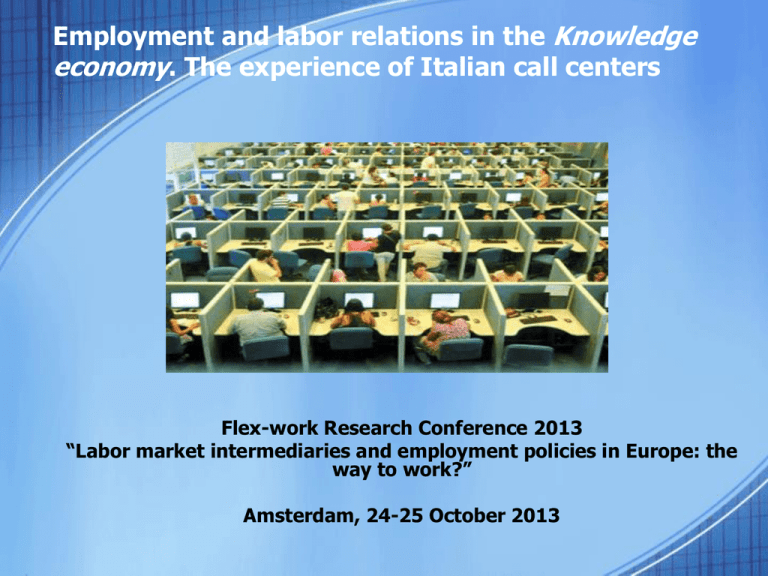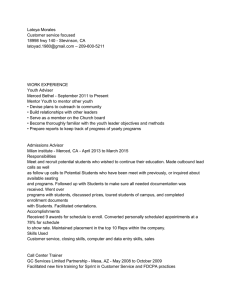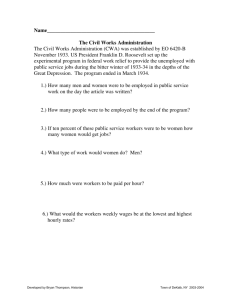Employment and labor relations in the Knowledge economy. The
advertisement

Employment and labor relations in the Knowledge economy. The experience of Italian call centers Flex-work Research Conference 2013 “Labor market intermediaries and employment policies in Europe: the way to work?” Amsterdam, 24-25 October 2013 The transformation of work changes in the macro-economic and socio-political climate are driving important changes in the nature of employment and work from industry to services de-manualisation, emphasis on knowledge/capabilities greater flexibility, and instability Employed people occupation Source: European Union Labor force survey - annual results 2012 Employment by sector 70.1 % of the employed persons in the EU worked in the service sector In 2012, more than two-thirds of all employed persons in the EU worked in services: - 39.6 % were involved in market-oriented services such as trade, transportation, accommodation and food services, information and financial activities and real estate. - 30.5 % were employed in public administration, education, human health, arts, entertainment and recreation and other services. - 24.9 % of employed persons worked in industry and construction, while agriculture accounted for 5.0 % (see Table 2). Sizeable differences still persist between Member States. Agriculture continues to be a significant source of employment in Romania (29.0 % of the working population in 2012), whereas it accounts for only a very small share (below 2 %) in Germany, Belgium, the United Kingdom, Luxembourg and Malta. The relevance of industry (manufacturing and construction) was highest in the Czech Republic (38.1 %) and Slovakia (37.5 %), and lowest in Luxembourg (12.7 %). The share of market services was highest in Cyprus (48.0 %), and non-market services were most prominent in Luxembourg (42.6 %). Of the women employed in the EU, 44.6 % worked in non-market services and 12.5 % in industry (including construction). For men, the picture is almost the reverse, as 35.2 % worked in industry and 18.6 % in non-market services. Employment by skill level and qualification 40.1 % of employed persons in the EU were skilled non-manual workers Skilled non-manual workers (i.e. legislators, senior officials, managers, professionals, technicians and associate professionals) made up the largest occupational group in the EU in 2012, accounting for 40.1 % of all employed persons. Luxembourg had the highest share (57.8 %). Skilled manual workers (e.g. plant and machine operators, craft workers) accounted for 23.7 % of total EU employment. In 2012, Romania (49.5 %) recorded the highest proportion of skilled manual workers followed by Poland (36.9 %). The proportion of men and women working as skilled manual workers in the EU is quite different: 36.3 % of all employed men and 8.7 % of all employed women. 9.1 % of employed persons in the EU had an elementary occupation, with Cyprus recording the highest share (17.1 %). Workers employed by economic sector in Italy 70 64.9 63.6 69.6 68.4 60 50 50 40 39 31.5 Industria 30.7 27.7 servizi 26.8 30 agricoltura 20 11 10 4.9 4.4 3.9 3.6 0 1981 1999 2004 2010 2013 The Italian paradox Unlike other countries, the increase in employment in the service sector has not affected the knowledge sector and the service industry (i.e. marketing, business consulting, advertising, etc.), but those areas that do not require particular specializations or skills. This refers, for example, to the call centre industry, catering, fast-food and cleaning work Possible explanations: - traditional and poorly innovative nature of the manufacturing industry, which does not require particularly advanced services, - prevalence of small (94% under 10 employees) and fragmented enterprises - organizational characteristics of the reality of services that only with difficulty absorb educated workers. Consequences: - Diffusion of service workers as opposed to professional and creative ones - an increasingly common condition of over-education and mismatch between acquired learning and work carried out The call center example Starting from these assumptions, we explored the “world” of call centers as a typical example of a new form of organization in the service sector economy. Callcenterization process (Huws 2009) at present Italian call centers employ around 80.000 workers and count 200 enterprises (among which only five of them control 60% of the whole market) for a business that reaches around 1 billion a year (65% represented by the telecommunication network) The research design Survey on call center operators findings are based on 1.715 questionnaires completed by workers of 19 call centers located in Lombardy, Lazio, Calabria and Sicily, selected in accordance with the size (in terms of number of workers employed), the private/public nature, the organizational typology (in-house or outsourcing), the kind of services delivered (generalist Vs dedicated), the workers’ tasks (inbound and outbound). The questionnaire consisted in 54 closed questions articulated in five broad sections covering aspects such as socio-demographic information; workers’ identity and motivation, education and previous work experiences; the nature of work and the main characteristic features; employment and labor relations; working conditions. Research aims and hypothesis increasing our knowledge on working conditions and employment relations in call center organizations In Italy call center jobs are not necessarily bad jobs associated to precarious forms of employment, high turn over, low wages and weak social protections. In certain contexts and in specific periods they may be considered as “socially acceptable”, not only as a first job or temporary occupation call center as an “opportunity” for those territories and local institutions able to attract and retain such organizations, using those practices defined as forms of “socio-territorial innovation” (Pierre and Tremblay 2012) and as a source of competitive advantages. Call center operators profile 90 80 24.6 70 26.5 15.3 60 17.7 50 40 26 35.8 19.5 7 5.6 30 8.9 20 10 19 19.2 26.1 13.4 13 10.1 Calabria Lazio 16 Lombardy 9.9 1.1 13 12.5 Sicily 0.4 0.8 9.8 26.4 3.4 9.6 9.4 0 20 - 25 26 - 30 31 -35 36 - 40 41 - 45 Over 46 n. r. Education level Table 4: Youths’ motivations to work per region – % values (respondents could give more than one answer to the question) Motivations Lombardy Lazio Calabria Sicily There are no other alternatives 24.2 19.2 28.4 28.2 Because it would fit in with my other commitments 32.8 27.4 15.7 24.1 Because of economic difficulties 25.8 20.2 29.5 24.5 Because it allows me to do other kinds of job 13.7 45.2 15.1 26 Because of its flexible working time/shifts 27.3 29.5 15.9 27.3 Because it allows me to get in touch with other people 15.9 31.9 23.2 29 Because I needed a temporary job 29.5 27.9 19.6 23 Because I needed a stable job 16.2 26.3 17.5 40 Because it was a regular and legally recognized job 6.1 31.3 31.3 31.3 Because I hoped to learn new competences 11.7 45 5 38.3 Because I believed I had the necessary attitudes 26.1 32.6 8.7 32.6 There are no other alternatives Because I was moved by the company 14.2 81 0 4.8 Because it would fit in with my other commitments Because of economic difficulties Other 11.5 42.3 26.9 19.3 n. r. 27.3 27.3 27.3 18.1 Motivations to work 4.7 4.3 4 34.9 9.5 23.4 Because it allows me to get in touch with other people Because I needed a stable job Because it allows me to do other kinds of job Trap or opportunity? Over a third of respondents (31.3%) have been working in the same call center from 1 to 3 years, Table 5: at present, are you searching for a new job? N. % No, because it is alright 553 32.2 No, because there are no other opportunities 429 25 No, for other reasons 167 9.7 6 0.3 Yes, I want a completely different job 344 20.1 Yes, I am looking for another job in addition to this one 94 5.5 Yes, for other reasons 72 4.3 n. r. 50 2.9 Total 1.715 100 Yes, because I wish to work in another call center 66.9% are not currently looking for a new job significant role played by personal characteristics such as young people’s age, gender and level of education, social context and the family of origin in terms of social, cultural and economic status that significantly influence young people’s expectations of work Table n.7: how did you find the job? I answered a job advertisement I sent an unsolicited application to a call center I went to a public job center (CPI) Through a private recruiting agency Through relatives, friends or known people Other n. r. Total N. 296 460 21 74 721 129 14 1.715 % 17.3 26.8 1.2 4.3 42.1 7.5 0.8 100 Skilled or low skilled workers? Competences required for the job (respondents could give more than one answer to the question) N. % University degree 74 4.3 High school diploma Relational - communicative competences 679 39.6 1.220 71.1 Information technology competences 706 41.2 Knowledge of foreign languages 148 8.6 Sale and marketing competences 224 13.1 Team-working orientation 784 45.7 Other 97 5.7 I did not sit any job interview or examination 69 4 In your working activity, how frequently do you use the following competences? Relational communicative competences Information technology competences Knowledge of foreign languages Sale and marketing competences Team-working orientation Never Sometimes Often Always n. r. 2.7 5.3 20.1 70.2 1.7 7.5 22.8 30 36.5 3.1 49.3 39.9 3.2 1.5 6.1 31.7 19.6 23.8 20.4 4.5 11.8 17.8 25 41.5 3.9 Employment contracts Typologies Lombardy Lazio Calabria Sicily Dependent with full time contract Dependent with fixed terms contract Labor training contract Project contract Occasional cooperation Stage, placement training Temporary contracts Other forms n. r. Total 46.8 11.5 5.7 29.4 3.3 0 2.4 0 0.9 100 60.4 20.9 0 12.5 0.2 0 5 0.6 0.4 100 42.3 12.2 1.4 40.1 0.5 0.5 0 1.1 1.9 100 50.2 20.7 3.4 10.3 0.2 2.2 9.3 2.6 1.1 100 Woorkers’ Tasks perfomed in the call center Tasks N. % Exclusively inbound operator 597 34.8 Pre-eminently inbound operator 360 21 Both inbound and outbound 179 10.4 Pre-eminently outbound operator 127 7.4 Exclusively outbound operator 415 24.2 n. r. 37 2.2 Total 1.715 100 Tasks performed and typologies of call center Tasks Private, generalist, outsourcing, + 200 employees Private, generalist, out-sourcing, 200 employees Private, dedicated, + 200 employees Private, dedicated, - 200 employees Public utility with more than 200 employees Public utility with less than 200 employees Total N. % N. % N. % N. % N. % N. % N. % Exclusively inbound operator 226 36.6 39 20 168 47.3 3 2.1 77 49.4 76 32.1 597 34.8 Pre-eminently inbound operator 133 21.6 17 8.7 67 18.9 8 5.7 66 42.3 65 27.4 360 21 Both inbound and outbound 78 12.6 20 10.3 29 8.2 21 15 11 7.1 17 7.2 179 10.4 Pre-eminently outbound operator 26 4.2 20 10.3 28 7.9 43 30.8 0 0 10 4.2 127 7.4 Exclusively outbound operator 132 21.4 94 48.2 60 16.9 65 46.4 1 0.6 63 26.6 415 24.2 n. r. 22 3.6 5 2.5 3 0.8 0 0 1 0.6 6 2.5 37 2.2 Total 617 100 195 100 355 100 140 100 156 100 237 100 1715 100 Salaries earned according to the call center operator task Range (salaries in euro) PrePreExclusively eminently Both eminently inbound inbound inbound and outbound operator operator outbound operator Exclusively outbound operator n. r. N. % N. % N. % N. % N. % N. % Less than 500 euro 17 2.8 4 1.1 5 2.8 20 15.7 157 37.8 4 10.8 From 500 to 800 euro From more than 800 to 1.000 euro From more than 1.000 to 1.300 euro From more than 1.300 to 1.500 euro 284 47.6 165 45.9 82 45.8 43 33.9 159 38.3 5 13.5 168 28.2 102 28.3 48 26.8 36 28.3 44 10.6 6 16.2 92 15.4 59 16.4 32 17.9 17 13.4 35 8.4 11 29.7 19 3.2 12 3.3 7 3.9 8 6.3 8 1.9 1 2.7 More than 1.500 euro 9 1.5 15 4.2 4 2.2 2 1.6 5 1.2 3 8.2 n. r. 8 1.3 3 0.8 1 0.6 1 0.8 7 1.8 7 18.9 Total 597 100 360 100 179 100 127 100 415 100 37 100 Human resources, employment and industrial relations Completely disagree Mainly disagree Mainly agree Completely agree n. r. N. % N. % N. % N. % N. % 271 15.8 498 29 769 44.8 142 8.3 35 2.1 185 10.8 504 29.4 820 47.8 172 10 34 2 164 9.6 416 24.3 894 52.1 201 11.7 40 2.3 436 25.4 683 39.8 442 25.8 100 5.9 54 3.1 They only care about company’ goals 257 15 479 27.9 554 32.3 383 22.3 42 2.4 They pay attention to working conditions 243 14.2 462 26.9 791 46.1 180 10.5 39 2.3 They take into account the wellbeing of workers They pay attention to what workers say They allow workers cooperation They do not pay attention to workers’ needs Managerial style in dealing with workers % values Search for workers’ commitment Greater attention to: • a pleasent working environment • reduced managerial control • good relationships among colleagues • Incentives 5.2 24.3 16.7 19.4 Authoritarian Friendly Cooperative 43.1 5.6 Conflictual Fair 65.2 Strict control Other Thinking about your call centre, how much do you agree with the following statements? Completely disagree N. The staff is motivated to work efficiently The training offered is adequate to perform the tasks required The organization is keen to exploit the individual potential The work is consistent with the contractual status of operators The results of operations are recognized and valued Operators are not provided with appropriate means to accomplish assigned projects The organization promotes the acquisition of new skills by workers % Mainly disagree N. % Mainly agree N. % Completel y agree N. 253 14.8 440 25.7 816 47.6 166 165 9.6 438 25.5 875 51 438 25.5 614 35.8 536 31.3 n. r. % N. % 9.7 40 2.2 193 11.3 44 2.6 83 4.8 44 2.6 254 14.8 433 25.2 781 45.5 194 11.4 53 3.1 390 22.7 580 33.8 596 34.8 98 5.7 51 3 388 22.6 671 39.1 494 28.8 111 6.5 51 3 289 16.9 578 33.7 674 39.3 117 6.8 57 3.3 Consequences deriving from missing the company targets (respondents could give more than one answer to the question) N. % 1.141 66.5 Penalties in terms of premiums and economic benefits 830 48.4 Worse employment relations 765 44.6 Obstacles in career opportunities 697 40.6 Non confirmation of the job 634 37 Job loss 633 36.9 Penalties in allocation of working tasks 591 34.5 Altro 43 2.5 Verbal warnings Workers’ level of satisfaction dissatisfaction about the following aspects Completely dissatisfied Mostly dissatisfied Mostly satisfied Completely satisfied n. r. N. % N. % N. % N. % N. % 737 43 483 28.2 384 22.4 51 3 60 3.5 Career opportunities 748 43.6 609 35.5 271 15.8 36 2.1 51 3 Possibility to count on a stable job 403 23.5 473 27.6 624 36.4 167 9.7 48 2.8 Receive an income suitable to the person’s needs 399 23.3 591 34.5 567 33.1 112 6.4 46 2.7 Decisional autonomy 425 24.8 549 32 602 35.1 93 5.4 46 2.7 401 23.4 588 34.2 598 34.9 82 4.8 46 2.7 Working relationship with superiors 259 15.1 436 25.4 822 48 148 8.6 50 2.9 Working relationship with colleagues 38 2.2 137 8 426 24.8 46 2.7 Possibility to make the most of the studies undertaken 754 44 532 31 318 18.6 54 3.1 57 3.3 Opportunity to reconcile work with private life 114 6.6 303 17.7 914 53.3 345 20.1 39 2.3 Possibility to count on a suitable pension Possibility to do interesting activities 1.068 62.3 Industrial relations Are you a union member? Yes, why? No, why V.a. Yes, to protect my interests and rights at the workplace 282 Yes, I believe in unions’ strategies and orientations 28 % 16,4 1,6 Yes, for ideological reasons 18 1 Yes, because of career opportunities 3 0,2 Yes, for the services delivered 27 1,6 Yes, due to I trust in the shop-stewards 44 2,6 Yes, for other reasons 19 1,1 Total 421 24,5 V.a. % No, in case of problems I directly talk to managers 354 20,7 No, due to Unions do not count a lot in the firm 213 12,4 No, I do not believe in the way unions behave 183 10,7 No, I do not trust in the shop-stewards 112 6,5 No, because of unions share company interests 45 2,6 No, due to the cost of the membership card 41 2,4 No, due to the lack of services delivered 37 2,2 No, due to I do not need of them No, if you are a union member you will never succeed No, I do not care No, I fear to loose the job No, but I think to join it No, due to union’ strategies weaken the company No, I did not think about it yet No, for other reasons n.r. 25 19 15 12 11 9 8 125 85 1,5 1,2 0,9 0,7 0,6 0,5 0,4 7,2 5 1.294 75,5 Total Concluding remarks Italian call center are a non-homogeneous reality, since organizational work and production modalities vary in function of some fundamental variables, such as the context in which the center operates, the business dimensions, the specialization of the activities or the size of the offer of the services, the work modality that is predominantly used, the public or private nature. To sum up - Differences related to the context: Polarization between North and South of the country and different workers’ profiles (age and education) 100 50 61.8 32 35.8 1.9 0 Calabria Lombardy under 30 over 40 90 80 70 60 50 40 30 20 10 0 81.9 27.7 0 29.8 42.5 12.7 16.3 11.3 17.8 5.5 Motivations: Traps/ Rational choice - Differences related to workers’ performance/tasks In-bound VS Out-bound social acceptable VS bad job Lombardy Calabria - Differences related to call center typologies and size: Big (and specialized) is better than Small (and generalist) Inbound task is more widespread in big size specialized or dedicated call centers (66.2%) and in the generalist ones (58.2%) - Differences related to public/private nature: Public call centers still represent an advantage public call centers and, above all, those with over 200 workers employ almost exclusively (91.7%) inbound operators (more specialized and less precarious) QUESTIONS Contact details Vincenzo Fortunato Department of Political and Social Sciences Università della Calabria (IT) vincenzo.fortunato@unical.it




